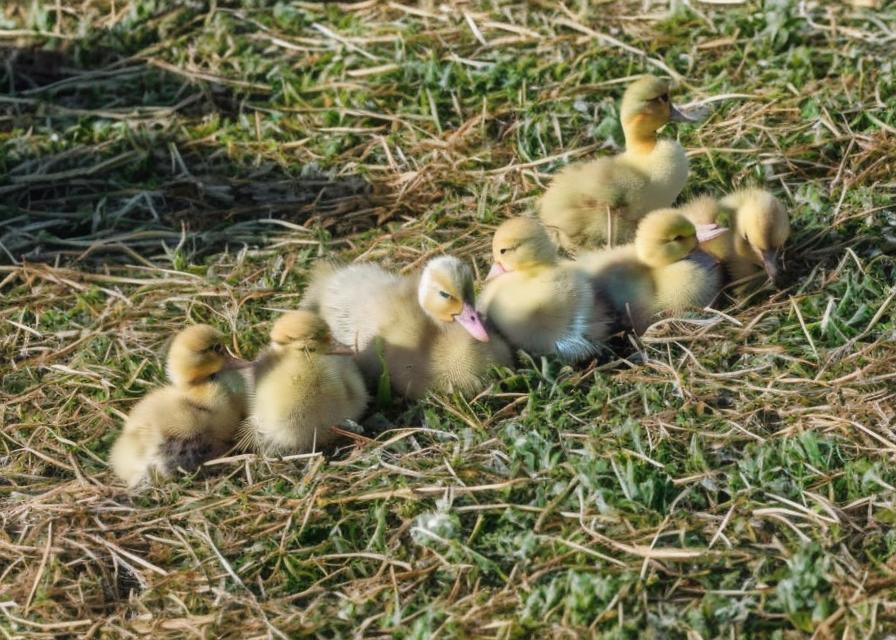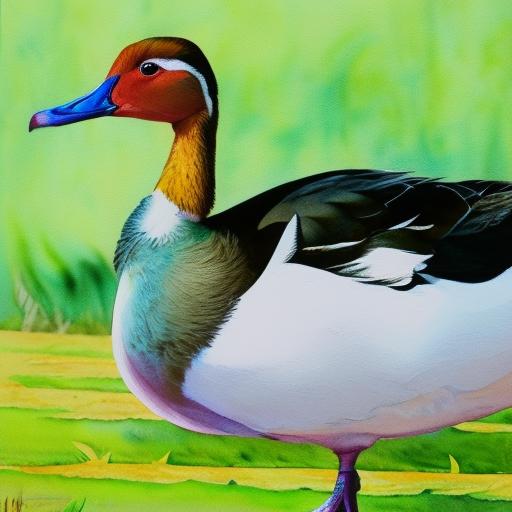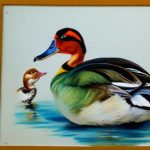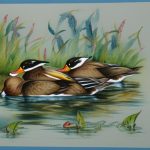Runner ducks are a unique and fascinating breed of domestic duck known for their upright, penguin-like stance and their ability to run rather than waddle. They are a lightweight breed, with long, slender bodies and legs, making them excellent foragers and efficient egg layers. Runner ducks come in a variety of colors, including fawn and white, black, chocolate, and blue. They are a popular choice for small farms and backyard poultry enthusiasts due to their friendly disposition and low maintenance requirements.
Runner ducks are known for their excellent foraging abilities, making them a great choice for pest control in the garden. They are also prolific egg layers, with some individuals laying up to 300 eggs per year. Their eggs are slightly smaller than those of other duck breeds but are still highly nutritious and delicious. Runner ducks are also known for their adaptability to various climates and their ability to thrive in both free-range and confined environments. They are generally hardy and easy to care for, making them an ideal choice for beginners and experienced duck keepers alike.
Key Takeaways
- Runner ducks are a unique breed known for their upright posture and excellent foraging abilities.
- When selecting breeding stock, look for ducks with good conformation, strong legs, and a healthy appearance.
- Breeding season for runner ducks typically begins in the spring, and mating behavior involves courtship displays and vocalizations.
- Incubation for runner duck eggs takes about 28 days, and hatching can be assisted by providing a warm, quiet environment.
- Caring for ducklings involves providing a warm brooder, clean water, and a balanced diet to support their growth and development.
- Health and nutrition considerations for runner ducks include providing access to clean water, a balanced diet, and regular veterinary check-ups.
- Selling and marketing ducklings can be done through local markets, online platforms, and networking with other poultry enthusiasts.
Selecting Breeding Stock
When selecting breeding stock for your runner duck flock, it’s important to choose healthy, well-tempered birds with good conformation and strong egg-laying abilities. Look for ducks that have a straight, upright stance, with well-proportioned bodies and legs. Avoid birds that are too small or too large for the breed standard, as this can indicate potential health or fertility issues. It’s also important to select ducks with good temperament, as aggressive or skittish birds can be difficult to handle and may pass on undesirable traits to their offspring.
In addition to physical traits, it’s important to consider the egg-laying abilities of your breeding stock. Look for ducks that come from lines known for high egg production and good fertility. Keep in mind that while male ducks (drakes) do not lay eggs, they still play a crucial role in breeding success. Choose drakes with good fertility and strong mating instincts to ensure successful reproduction within your flock. When selecting breeding stock, it’s also important to consider genetic diversity to avoid inbreeding and maintain the overall health and vigor of your flock.
Breeding Season and Mating Behavior
Runner ducks typically reach sexual maturity at around 5-6 months of age, at which point they will begin to exhibit mating behaviors. Breeding season for runner ducks usually begins in the spring and can continue through the summer months. During this time, drakes will become more vocal and may engage in displays of courtship behavior, such as head bobbing and wing flapping, to attract females. Female ducks may also become more vocal and receptive to mating advances from the drakes.
Mating behavior in runner ducks is typically initiated by the drakes, who will pursue and attempt to mount the females. It’s important to provide adequate space and privacy for mating pairs to ensure successful reproduction. In a natural setting, runner ducks will often mate in or near water, so providing a shallow pond or water source can encourage natural mating behavior. It’s also important to monitor mating behavior closely to ensure that all females have the opportunity to mate and that aggressive behavior is kept to a minimum within the flock.
Incubation and Hatching
After successful mating, female runner ducks will begin to lay eggs, typically one egg per day until they have laid a full clutch of eggs. Runner ducks are known for their broodiness, or their tendency to sit on and incubate their eggs until they hatch. However, some individuals may not exhibit strong brooding instincts, so it’s important to monitor egg laying closely and provide alternative incubation methods if necessary.
If you plan to allow your ducks to incubate their own eggs, it’s important to provide a quiet, secluded nesting area with plenty of soft bedding material for the female to create a nest. Ensure that the nesting area is safe from predators and other disturbances that could disrupt the incubation process. If your ducks do not exhibit strong brooding instincts, you may need to consider artificial incubation methods using an incubator to ensure the eggs have the best chance of hatching successfully.
Once the eggs have been laid and incubation has begun, it’s important to monitor the nesting area closely to ensure that the female is caring for her eggs properly. Provide fresh water and food nearby to ensure that the female has access to essential nutrients during this time. The incubation period for runner duck eggs is approximately 28 days, after which the ducklings will begin to hatch.
Caring for Ducklings
Once the ducklings have hatched, it’s important to provide them with a warm, safe environment to thrive. Ducklings are particularly vulnerable in their first few weeks of life and require careful attention and care to ensure their health and well-being. Provide a brooder with a heat lamp or heating pad to maintain a temperature of around 90-95 degrees Fahrenheit for the first week, gradually decreasing the temperature by 5 degrees each week until they are fully feathered.
In addition to warmth, ducklings require access to clean water for drinking and bathing, as well as a high-quality starter feed specifically formulated for waterfowl. It’s important to monitor the ducklings closely for signs of illness or distress and provide prompt veterinary care if necessary. Socialization is also important for young ducklings, so be sure to spend time handling and interacting with them regularly to help them become accustomed to human contact.
As the ducklings grow, they will begin to develop their own unique personalities and behaviors. Runner ducklings are known for their curious and active nature, so providing plenty of space for them to explore and exercise is essential for their overall well-being. With proper care and attention, your runner ducklings will grow into healthy, happy adults ready to join your flock or find new homes.
Health and Nutrition Considerations

Maintaining the health and well-being of your runner ducks is essential for a successful breeding program. Providing a balanced diet rich in essential nutrients is crucial for overall health and reproductive success. A high-quality commercial waterfowl feed formulated specifically for ducks is an excellent choice for providing essential vitamins, minerals, and protein necessary for egg production and overall health.
In addition to a commercial feed, it’s important to provide access to fresh water at all times, as well as access to natural foraging opportunities if possible. Runner ducks are excellent foragers and will happily consume insects, grasses, and other natural foods as part of their diet. However, it’s important to monitor their diet closely to ensure they are receiving all the necessary nutrients for optimal health.
Regular veterinary check-ups are also important for maintaining the health of your breeding stock. Routine vaccinations, parasite control, and regular health checks can help prevent illness and ensure that your ducks are in prime breeding condition. It’s also important to provide a clean living environment with plenty of space for exercise and socialization to promote overall health and well-being.
Selling and Marketing Ducklings
Once your runner ducks have successfully hatched a new generation of ducklings, you may find yourself with more ducklings than you can accommodate in your own flock. Selling ducklings can be a rewarding way to share these delightful birds with others while also generating income for your breeding program. There are several avenues you can explore when it comes to selling ducklings, including local farm markets, agricultural fairs, online marketplaces, and direct sales to other poultry enthusiasts.
When marketing your ducklings, it’s important to highlight the unique qualities of runner ducks, such as their excellent egg-laying abilities, friendly disposition, and adaptability to various environments. Providing potential buyers with information about the care and housing requirements of runner ducks can also help ensure that they are prepared to provide a suitable home for their new feathered friends.
In addition to marketing directly to individuals looking to add runner ducks to their flocks, you may also consider selling hatching eggs or started pullets (young female ducks) as an alternative revenue stream. Providing high-quality birds with good genetics and strong egg-laying abilities can help build a positive reputation for your breeding program and attract repeat customers.
In conclusion, breeding runner ducks can be a rewarding endeavor for poultry enthusiasts looking to raise unique and productive waterfowl. By selecting healthy breeding stock with strong genetic traits, providing proper care during breeding season and incubation, and maintaining the health and well-being of your ducklings through proper nutrition and care, you can create a successful breeding program that produces high-quality runner ducks for sale or personal enjoyment.
If you’re interested in breeding runner ducks, you may also want to check out this informative article on “What Should You Feed Ducks” from Poultry Wizard. Understanding the dietary needs of ducks is crucial for their health and productivity. This article provides valuable insights into the nutritional requirements of ducks and offers practical tips on feeding them for optimal growth and egg production. For more helpful resources on poultry care, visit Poultry Wizard’s website. (source)
FAQs
What are runner ducks?
Runner ducks are a breed of domestic duck known for their upright, penguin-like stance and their ability to run rather than waddle. They are popular for their egg-laying abilities and are often kept for both ornamental and practical purposes.
How do you breed runner ducks?
Breeding runner ducks involves selecting healthy, unrelated ducks for mating, providing a suitable nesting area for the female, and ensuring proper nutrition and care for the ducks and their offspring. Breeding can occur naturally or through artificial insemination.
What is the breeding season for runner ducks?
Runner ducks typically breed in the spring and summer months, with peak egg-laying occurring during this time. It is important to provide a suitable environment for breeding ducks during this season.
How many eggs do runner ducks lay?
Runner ducks are known for their prolific egg-laying abilities, with females laying an average of 150-200 eggs per year. Proper nutrition and care can help maximize egg production.
What are some common health issues in breeding runner ducks?
Common health issues in breeding runner ducks include respiratory infections, parasites, and reproductive disorders. It is important to monitor the health of breeding ducks and seek veterinary care when necessary.
What should I consider before breeding runner ducks?
Before breeding runner ducks, it is important to consider the space and resources needed to care for the ducks and their offspring, as well as the market for ducklings or eggs. It is also important to have a basic understanding of duck behavior and breeding practices.
Meet Walter, the feathered-friend fanatic of Florida! Nestled in the sunshine state, Walter struts through life with his feathered companions, clucking his way to happiness. With a coop that’s fancier than a five-star hotel, he’s the Don Juan of the chicken world. When he’s not teaching his hens to do the cha-cha, you’ll find him in a heated debate with his prized rooster, Sir Clucks-a-Lot. Walter’s poultry passion is no yolk; he’s the sunny-side-up guy you never knew you needed in your flock of friends!







